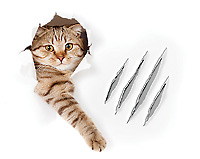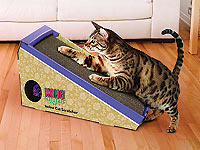Thankfully, the practice of declawing cats is slowly going the way of the dinosaurs. More and more pet parents and veterinarians are realizing declawing is an inhumane procedure because it involves cutting off the ends of a cat’s toes. Contrary to popular belief, it isn’t a nail trim or even nail removal.
A declaw, or onychectomy, is the amputation of the claw, bones, nerves, joint capsule, collateral ligaments and the extensor or flexor tendons. This amputation alters the conformation of the cat’s feet, which can lead to significant physical complications such as chronic small bone arthritis, degenerative joint disease and neuralgia.
 The good news is the majority of housecats these days aren’t undergoing brutal toe amputations. The not-so-good news is that unless you take steps to prevent it, those sharp little claws can do big-time damage to your furniture, carpets, drapes, and other surfaces around your home. The good news is the majority of housecats these days aren’t undergoing brutal toe amputations. The not-so-good news is that unless you take steps to prevent it, those sharp little claws can do big-time damage to your furniture, carpets, drapes, and other surfaces around your home.
Cats react to their environment, our job is to learn how to redirect the scratching to an appropriate surface. And it’s the same type of thing with almost anything in the cat’s environment. It’s just a matter of educating humans about cats’ needs as wild carnivorous predators. We’ve taken cats from the outside and put them into our homes. How do we recreate what they need in our homes?
Step No. 1: Observe How and Where Your Cat Uses Her Claws
Cats are digitigrades, meaning they walk on their toes. Most other mammals, including humans, walk on the soles of their feet. Kitties use their claws for balance, exercise, and stretching and toning the muscles of their legs, back, shoulders and paws.
Cats who roam outdoors use their claws to hunt and capture prey, to escape or defend against predators, and as part of feline marking behavior. Since scratching is an instinctual feline behavior, it’s important to give indoor kitties access to a variety of scratching surfaces.
Cats vary in the ways they scratch and the surfaces they prefer. If you’ve just brought home a new kitten or adult cat, ideally you planned ahead by setting up appropriate scratching surfaces around your home. You’ve directed her clawing activities to those surfaces, and she’s getting the hang of it.
But what if that’s only what you wish you’d done (or tried unsuccessfully to do), and kitty is now systematically shredding the corner of your sofa or a section of your carpet?
First, observe her scratching behavior and try to match your scratcher purchase to it. Some kitties scratch horizontally. Some reach high overhead vertically for a good backstretch. Some lie on their backs and scratch a surface above them like the filmy fabric underside of the box spring on your bed, for example. And some cats incorporate a variety of clawing activities into their repertoire. Also observe what types of surface your cat prefers to scratch. Some cats choose soft fabric while others like wood flooring.
Next, buy or make cat scratchers that will satisfy both your kitty’s preferred scratching position and surface. This might involve more than one scratcher design, for example, a carpet-covered post, a sisal-covered post and a post with both horizontal and vertical scratching surfaces. Scratching posts should be very sturdy (no wobbling) and remain stable during clawing sessions.
Step No. 2: Direct or Redirect Kitty’s Clawing Activity to His Scratchers
When you have your scratching surfaces ready to go, they need to be placed where they’ll be used. Remember: clawing is in part a marking behavior for your cat, so it’s likely he’s returning to the same place to scratch.
It’s doubtful your cat scratchers compliment the décor of your home, but unfortunately, they need to be located as close to that sofa corner or section of carpet as possible in order to entice kitty. You can also try locating one in front of the window he looks out of, his feeding area or litterbox. Sticking the scratchers in out-of-the-way spots your cat doesn’t frequent is unlikely to encourage him to use them.
Like the litterbox rule for multi-cat households (one litterbox per cat plus one extra), it’s a good idea to have one more scratcher than you have cats. So if you have two kitties at home, a good rule of thumb is to have three scratching surfaces. Many cats don’t like to share their scratching territory.
Once you’ve got your scratchers in position, the next challenge is to get kitty aimed in the direction of the new target. Encourage your cat to explore the scratcher using a lure like a feather toy or a toy with some catnip rubbed on it. You can also rub or sprinkle organic catnip directly on the scratchers.
Offer praise and treats each time your cat uses a scratcher and especially when he digs his claws into it. Pet him and give him the kind of positive reinforcement he responds to. The idea is to make it a pleasant, fun experience each time he uses the new scratching surfaces.
Step No. 3: Extinguish Inappropriate Scratching
While you’re training your cat to use appropriate scratching surfaces, you’ll also need to make any illegal surfaces she’s fond of as unattractive as possible to her. Depending on what surfaces you want to protect, consider using some or a combination of the following deterrents:
- • Aluminum foil
• Double-sided tape (your kitty won’t tolerate the feel of sticky tape on his paws)
• Plastic sheeting
• Plastic carpet runners, or car or office chair mats with the spiky sides up
• Inflated balloons
If you’re covering surfaces you need to use frequently, like furniture, you can attach the foil, tape or plastic to pieces of cardboard and easily move them in and out of position.
There are also herbal sprays available that are designed to replace your pet’s paw pad scent markers on furniture or other surfaces with an odor that will discourage her from returning to that spot. I use lemon essential oil mist on my furniture corners to discourage scratching; many cats dislike citrus.
In addition, just as most humans need to trim their nails frequently, it may be necessary to trim your cat’s nails weekly or at least every couple of weeks. You can also consider covering her nails with commercially available nail caps, which will help protect both you and your belongings from those sharp claws.
Bottom Line: Clawing and Scratching Goes With the Territory When You’re a Cat Parent
As a current or prospective cat parent, it’s important to realize there are some cats that no matter what you do, will continue to scratch forbidden surfaces and potentially damage your belongings. Cats simply aren’t as easy to train as dogs are.
Having a cat around the house means you’re sharing your life with an animal that will never be entirely domesticated. At the risk of discouraging people from adopting a cat, I suggest that if you absolutely can’t live with an animal who has sharp claws and scratches things with them, you might want to avoid getting a kitty. Another option is to check with your local shelters and rescue groups for homeless cats that have already been declawed.
If you have or plan to adopt a kitty with claws, the humane solution to unwanted scratching is to provide sensible, appealing options for your cat. Felines have claws for a reason, and as long as they have them, they’ll use them.
Dog-Friendly Walks/Hikes
in the Moab Area |
Corona Arch - Easy/Moderate. 1.3 Miles one way. Trailhead is 25 minute drive from Moab. North on US-191 to Potash Road (Utah 279).
Mill Creek Pathway - Easy. 1.1 Miles. Little to no driving. Starts at the intersection of 100 South and 100 West, a block off of Main Street.
Portal Overlook - Hard. 2.0 Miles one way. Trailhead is 20 minute drive from Moab. N. on US-191 to Potash Road (Utah 279).
Grandstaff Canyon - Moderate. 2.0 Miles one way. Trailhead is 10-minute drive from Moab. North on US-191 to the River Road (Utah 128) |
|